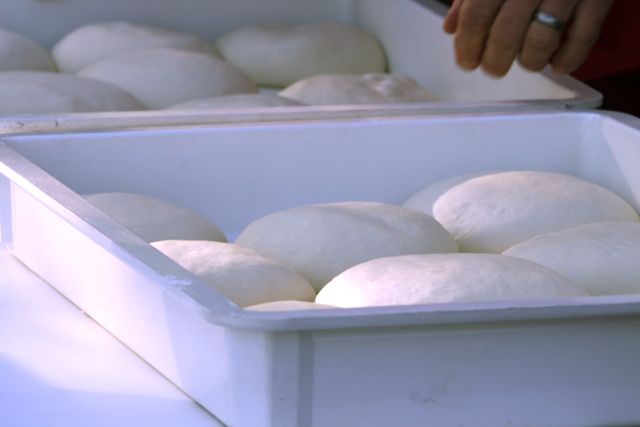Classic Pizza Dough, Neo-Neapolitan-Style
Classic Pizza Dough, Neo-Neapolitan Style
(Makes five 8-ounce pizzas)
What makes this Neo-Neapolitan is that I use American bread flour instead of Italian -00- flour, but you can certainly use Italian flour, such as Caputo, if you want to make an authentic Napoletana dough. Just cut back on the water by about 2 ounces, since Italian flour does not absorb as much as the higher protein American flour. Always use unbleached flour for better flavor but, if you only have bleached flour it will still work even if it doesn’t taste quite as good. If you want to make it more like a New Haven-style dough (or like Totonno’s or other coal-oven pizzerias), add 1 tablespoon of sugar or honey and 2 tablespoons of olive oil. These are optional–the dough is great with or without them. As with the Country Dough, the key is to make it wet enough so that the cornicione (the edge or crown) really puffs in the oven.

Neo-Neopalitan dough in proofing trays
5 1/4 cups (24 ounces by weight) unbleached bread flour
2 teaspoons (0.5 oz.) kosher salt
1 1/4 teaspoons (0.14 oz.) instant yeast (or 1 1/2 teaspoons active dry yeast dissolved in the water)
2 tablespoons (1 oz.) olive oil (optional)
1 tablespoons (1/2 oz.) sugar or honey (optional)
2 1/4 cups (18 oz.) room temperature water (less if using honey or oil)
–You can mix this by hand with a big spoon or in an electric mixer using the paddle (not the dough hook).
–Combine all the ingredients in the bowl and mix for one minute, to form a coarse, sticky dough ball.
–Let the dough rest for five minutes, then mix again for one minute to make a smooth, very tacky ball of dough.
–Transfer the dough to a lightly oiled work surface, rub a little oil on your hands, and fold the dough into a smooth ball. Let it rest on the work surface for 5 minutes and then stretch and fold the dough into a tight ball. Repeat this again, two more times, at 5 minute intervals. Place the dough in a lightly oiled bowl, cover with plastic wrap, and immediately place in the refrigerator. The dough can be used anywhere from 6 hours to three days after it goes in the fridge.
— (Note: the following steps are the same as for the Country Pizza Dough:) When ready to make the pizzas, pull the dough from the refrigerator two hours prior to when you plan to bake. Divide the dough into five 8-ounce pieces (if there is any extra dough divide it evenly among the dough balls). With either oil or flour on your hands, form each piece into a tight dough ball and place on a lightly oiled pan. Mist the dough balls with spray oil and cover loosely with plastic wrap or place the pan inside a large plastic bag. Give the dough at least 90 minutes before making the pizzas. If you don’t plan to use them all, place the extra dough balls inside of an oiled freezer bag and keep in the refrigerator (for up to three days) or in the freezer (for up to three months).
–If using a pizza stone in your home oven, preheat the oven to the highest setting
one hour before you plan to make the pizzas. If using a wood-fired oven, you know what to do for your particular oven. If you do not have a baking stone you can bake the pizzas on a sheet pan.
–Top with your favorite toppings–this dough can be stretched thin (12-13 inches) for Roman-style pizzas, or 10-11-inches for Naples-style.
Recent Articles by Peter Reinhart
- Peter Scott Ruben: Why Frank Sinatra is the true “Chairman of the Board,” and the Greatest of the Greats
- Elizabeth Brasch, Mellow Mushroom’s Has a Vision
- Nipun Sharma: Pizza’s A-I Robotics Future is Now
- Maui Pizza with Chef Jeff Scheer of Restaurant Marlow
- The Pizza Yodi’s Are Back –John Arena and Brian Spangler are in the House!
- Arthur Bovino and Alfred Schulz and Their Pizza Pod Party
Add Comment
You must be logged in to post a comment.










I am a big believer in just raw plum tomatoe product run through a food mill with a little salt to develop flavor you add seaonings tp the assembled Pie and Herbs go on last after cooking like Basil or freash oregano. Less is more! The more people try an doctor up sauce the more they mess it up.
Thanks Joe! Any tips on the seasonings? 🙂
Yes! What’s great about this is lattitude. There is no universal sauce. Other than plain. So for me fresh garlic n EVOO is a given, S&P, Basil on a margherite. Oregano w/ pepperoni and a sasage pie Shines with a chiffonade of fresh sage no oregano.also play w cheeses adding a liitle provolone or assiago in addition to Mootz. Season that compliments toppings!
For how long would you mix this dough in a commercial mixer? And would you do it on speed 1 or 2? Usually its a mix of both speeds??
Is there a formula to know how long you can mix dough for not to overwork it or overproduce gluten?
Im interested in using this dough for a restaurant with a Woodfire Gas Forno Oven. We sell 50+ pizzas a day and I need a formula that can proof enough in a few hours if necessary.
I’m an American chef who just opened a restaurant in Boquete, Panama. There are a LOT of pizza nerds here and we have been working to perfect our crust which tends to be doughy in the center. We are using 7oz dough balls in our Woodstone oven. One of my many questions is….in a restaurant application, how do I deal with bringing your dough to room temperature when you don’t know if you’ll be selling 10 pizzas or 30 pizzas?